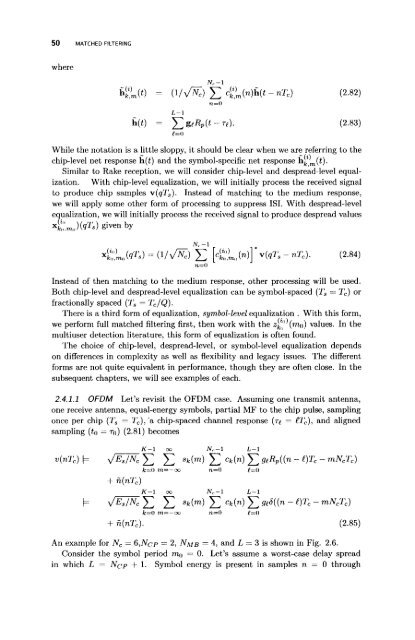mohatta2015.pdf
signal processing from power amplifier operation control point of view
signal processing from power amplifier operation control point of view
You also want an ePaper? Increase the reach of your titles
YUMPU automatically turns print PDFs into web optimized ePapers that Google loves.
50 MATCHED FILTERING<br />
where<br />
É£>) = (l/^ëc^HMi-nYi) (2.82)<br />
n=(l<br />
L-l<br />
h(i) = Y^gtRp{t-T t ). (2.83)<br />
i=(l<br />
While the notation is a little sloppy, it should be clear when we are referring to the<br />
chip-level net response h(i) and the symbol-specific net response h¡¿ m(t)·<br />
Similar to Rake reception, we will consider chip-level and despread-level equalization.<br />
With chip-level equalization, we will initially process the received signal<br />
to produce chip samples v(qT s ).<br />
Instead of matching to the medium response,<br />
we will apply some other form of processing to suppress ISI. With despread-level<br />
equalization, we will initially process the received signal to produce despread values<br />
x fe,'.m„)(9'- , s) s iven b y<br />
n=()<br />
Instead of then matching to the medium response, other processing will be used.<br />
Both chip-level and despread-level equalization can be symbol-spaced (T s = T c ) or<br />
fractionally spaced (T s = T c /Q).<br />
There is a third form of equalization, symbol-level equalization . With this form,<br />
we perform full matched filtering first, then work with the z¿ (mo) values. In the<br />
multiuser detection literature, this form of equalization is often found.<br />
The choice of chip-level, despread-level, or symbol-level equalization depends<br />
on differences in complexity as well as flexibility and legacy issues. The different<br />
forms are not quite equivalent in performance, though they are often close. In the<br />
subsequent chapters, we will see examples of each.<br />
2.4.1.1 OFDM Let's revisit the OFDM case. Assuming one transmit antenna,<br />
one receive antenna, equal-energy symbols, partial MF to the chip pulse, sampling<br />
once per chip (T s = T c ),'a chip-spaced channel response (re — ÍT C ), and aligned<br />
sampling (io = r 0 ) (2.81) becomes<br />
K-\ oc N,.-l L-l<br />
v(nT c ) \= s/E s /N c Σ Σ Sfc ( m ) Σ Ck M Σ 9(Rp(( n ~ Wc ~ mN c T c )<br />
fc=() m=-oo n=0 {=(><br />
+ ñ(nT c )<br />
K-l oo JV,.-1 L-l<br />
h y/E,/N c Σ Σ Sfc(m) Σ C fc(") Σ »*((" - £ ) T ' - mN c T c)<br />
fc=0 m=-oc n=0 f=()<br />
+ ñ(nT c ). (2.85)<br />
An example for N c = 6,NCP = 2, NMB = 4, and L = 3 is shown in Fig. 2.6.<br />
Consider the symbol period mo = 0. Let's assume a worst-case delay spread<br />
in which L = Ncp + 1. Symbol energy is present in samples n = 0 through



